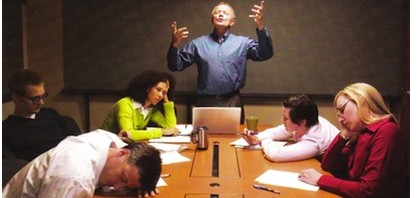One of the biggest problems in organizations is that the meeting is a tool that is used to diffuse responsibility. ~Al Pittampalli
Death by Meeting is t he title of one of Patrick Lencioni’s bestselling books. I was reminded of this book title when I heard an interview this week on NPR with consultant and author, Al Pittampalli. Here’s a brief excerpt:
he title of one of Patrick Lencioni’s bestselling books. I was reminded of this book title when I heard an interview this week on NPR with consultant and author, Al Pittampalli. Here’s a brief excerpt:
Bryan Stockton, CEO at Mattel came as the toymaker’s best-known brands like Barbie stagnated and it was losing business to Web-based games. Stockton himself said that Mattel lacked an innovative culture and blamed it in part on something specific: bad meetings.
Experts say poorly run meetings grind away at employee engagement and make companies less reactive by bogging decisions down in human red tape. Some companies, including Mattel, try to create limits around the size, duration or frequency of meetings.
But meetings often last longer than they need to because managers don’t understand Parkinson’s Law. This is the idea, backed up by research, tasks take as long as the time allotted. If you budget two hours, it takes two hours.
Pittampalli says, “We’ve fallen victim to mediocre meetings, not about coordination but about bureaucratic excuse making and the kabuki dance of company politics. We’re now addicted to meetings that insulate us from the work we ought to be doing. By isolating and destroying the mediocre meeting, we can revamp the way projects are organized, decisions are made, and work gets done.”
He sees “not just marathon meetings, but meetings that are done to prepare for meetings, and meetings that are done to prepare for meetings to prepare for meetings. It is a waste of time — it’s what I call a weapon of mass interruption.”
It’s also expensive to waste employee time. So why does the practice persist?
“One of the biggest problems in organizations is that the meeting is a tool that is used to diffuse responsibility,”Pittampalli says.
He says meetings alleviate the anxiety of making tough calls by delaying decisions, instead of making them.
Breathe a little life into your meetings with these three steps.
- Know why you’re meeting, and make sure everyone else knows as well (write the purpose/objective of the meeting boldly on the agenda).
- Schedule the meeting for 25%-50% fewer minutes than you think you need.
- End the meeting with action items and individuals assigned to those action items with timelines. (If you skip this step, chances are you didn’t make any decisions and possibly wasted everyone’s time).